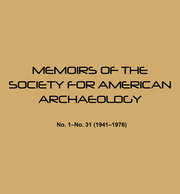No CrossRef data available.
Article contents
The Bertelson Suquamish Collection
Published online by Cambridge University Press: 27 June 2018
Extract
Ernest Bertelson began his collecting twenty or twenty-one years ago on a sandy spit on the former Suquamish Indian Reservation at Suquamish, Washington. Suquamish is on the west shore of Puget Sound almost directly across from Seattle and the spit lies south of the present Seattle-Suquamish ferry landing. On this same point of land, once stood the renowned Old Man House, largest aboriginal structure of the American Northwest. The bulk of the collection consists of chipped stone artifacts, varying in workmanship from beautifully finished points to crudely worked flakes and pecked cores. Some polished stone, a few bone pieces, and one piece of copper are also included. Mr. Bertelson moved away from Suquamish in 1944 and the collection, which has been kept intact, is now housed with his brother in Minnesota. By the summer of 1945 the spit was surveyed and divided into small building lots for the erection of a summer colony so that the possibility of obtaining further information is slight indeed.
- Type
- Research Article
- Information
- Copyright
- Copyright © Society for American Archaeology 1950
References
1 Bertelson, communication.
2 Both of these are included in the “Suquamish” village; see M. W. Smith, 1941, p. 207.
3 Not to be confused with Kitsap, the Muckleshoot warrior (Curtis, 1913, p. 14), nor with Old Kitsap, the Puyallup warrior (M. W. Smith, 1940b, p. 328).
4 Details concerning the construction of Old Man House and the men who built it were obtained during ethnological investigations from Sam Wilson, a Suquamish. Statements such as this, therefore, are taken from personal field notes: many of them may also be found in the various published accounts of Old Man House. Sam Wilson's home, the former Indian Agent's house at Suquamish, was on high ground not far from the Old Man House spit and he belonged to the same village as the builders. I am sorry to have to add that Mr. Bertelson has written me of his death, which occurred in June, 1941.
5 M. W. Smith, 1940a, p. 11; 19406, pp. 26-7, 140, 243-5; 1941, p. 201.
6 Wickersham, 1900, p. 145.
7 Bertelson, communication.
8 M. W. Smith, field notes.
9 Strong, Schenck, and Steward, 1930, pp. 89-90; Steward, 1928.
10 In descriptions of material culture from living informants of this area (M. W. Smith, 19406, p. 298, etc.)
“fitting into the hand,” or “fitting the thumb,” etc., is a constantly recurring refrain. It does not seem too farfetched, therefore, to apply it to these artifacts.
11 Bertelson describes this as “lighter than the basalt and of different texture” and thinks it is of local origin
12 Strong, Schenck, and Steward, 1930, pp. 86-7.
13 Ibid., Fig. 12.
14 Ibid., p. 87.
15 Ibid., Pl. 16, 1.
16 See M. W. Smith, 1946.
17 Strong, Schenck, and Steward, 1930, p. 86.
18 Three of the X-type classifications, peculiar to points of the Bertelson Collection, were made by Philip Drucker when he worked with the materials, the remaining Xclassification and the size groupings of Table 1 were made by me when all the collection was at hand.
19 Strong, 1935, p. 88.
20 M. W. Smith, 1940b, p. 275.
21 H. I. Smith, 1899a, Fig. 43, p. 142.
22 Olson, 1927.
23 Leatherman and Krieger, 1940, Pl. VIII.
24 Hill-Tout, 1938, Pl. of Eburne.
25 Wickersham, 1900, p. 144.
26 Strong, Schenck, and Steward, 1930, pp. 112-14.
27 Drucker, 1943.
28 De Laguna, 1947, pp. 154-62.
29 M. W. Smith, 1940b, p. 250; but see also wooden mortar, p. 278.
30 Ibid., pp. 322, 323. See also H. I. Smith, 1899c.
31 M. W. Smith, 19406, p. 144; and field notes.
32 See Footnote 4, of this section.
33 H. I. Smith, 1903, Fig. 23, c. (Same figure as H. I. Smith, 1923, Pl. 3, 2.)
34 Wickersham, 1900, p. 143.
35 Eells, 1886. See also H. I. Smith, 1899c; 1906c, especially p. 304; and Seaman, 1946, p. 119.
36 Boas, 1904, pp. 412-18; Hill-Tout and Kidd, 1932; H. I. Smith, 1904a, p. 440; M. W. Smith, 19406, p. 322; Wickersham, 1900, p. 146. Cf. Haeberlin and Gunther, 1930, pp. 13-14.
37 M. W. Smith, 19406, p. 116.
38 Strong, Schenck, and Steward, 1930, Pl. 8, g.
39 Drucker, 1943, p. 41.
40 Reagan, 1917.
41 Smith and Fowke, 1901.
42 Ibid., p. 58.
43 M. W. Smith, 19406, pp. 201-05. Cf. Haeberlin and Gunther, 1930, pp. 54-5.
44 M. W. Smith, 1946, pp. 311, 316-17, etc. Wicker sham (1896) mentions seeing mortuary houses on both the west coast of Vancouver Island and at Queets with American-made windows.
45 Strong, Schenck, and Steward, 1930.
46 Reagan, 1917, p. 10.
47 Ibid., p. 29.


